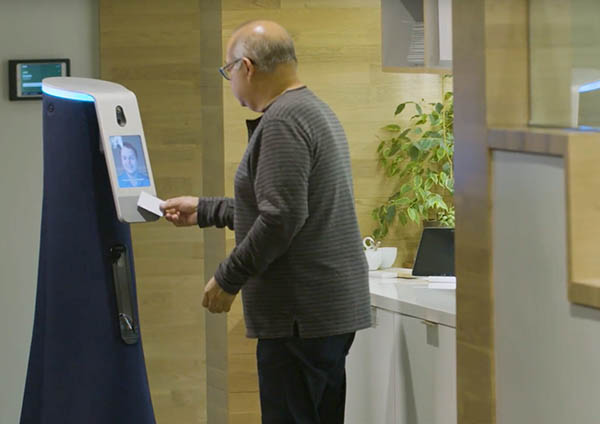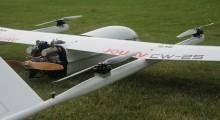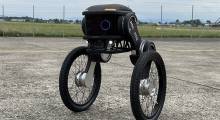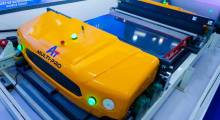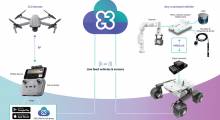Cobalt Robotics Inc. and Safetrust Inc. this week announced that they have further integrated Cobalt's autonomous security robots with Safetrust's sensor ecosystem.
“Safetrust is a pioneer in identity, utilizing technology to offer employees safe, frictionless movement throughout their spaces,” stated Mike LeBlanc, president of Cobalt Robotics. “Our robots provide the same comfortable and effective solution for companies around the world. We’re proud to continue building the future of security with Safetrust.”
Fremont, Calif.-based Cobalt Robotics claimed that it is the only company to automate repetitive manual security and facility tasks. It offers an integrated service that unifies robotics, machine learning software, and expert human oversight.
The company said its technology and dedicated professional security services team can improve safety, security, and facility workflows with greater efficiency and predictability at substantially reduced costs. This allows human guards to focus on tasks that require judgment, empathy, and decision making, said Cobalt.
“The role of robots in facilities management is expanding from monitoring and cleaning to security,” LeBlanc told Robotics 24/7.
Cobalt provides Remote Guarding Service
Cobalt Robotics said its autonomous mobile robots (AMRs) can help companies protect both their employees and intellectual property. The company counts leading enterprises such as General Motors and Slack among its customers. Cobalt noted that its robots primarily operate in corporate office spaces.
“Our robot also helps facilities to be ADA [Americans With Disabilities Act]-compliant,” LeBlanc said. “Spaces need to be set up for indoor robots, and we know how to navigate and avoid obstacles.”
Cobalt’s Remote Guarding Service Solution includes robots with more than 60 sensors. They include day-night cameras, 360-degree cameras, thermal cameras, depth cameras, lidar, and badge-reading capabilities.
“When we look at the security industry, it's difficult to replace a security guard because of the flexibility of tasking, and guards understand customer needs,” said LeBlanc. “However, robots love repetitive tasks, and Cobalt excels because we play well with other security systems.”
Using machine learning, semantic mapping, and novelty detection, the robot can independently identify and flag security-relevant anomalies like sounds, motion, doors, windows, and missing assets. Each robot has a screen for communication between remote security specialists and people on site, said Cobalt.
In the event of an incident, the specialists can provide human assistance for complex situations. They will triage the incident, contact appropriate personnel, and report back to the 24/7 security team based on collaboratively established post orders.
“With a global central operations center, a robot can check on an alarm and directly report findings,” LeBlanc explained. “The system filters information for security guards, and then robots or guards can follow up on alarms directly to those points.”
AMR designed to facilitate interaction
Cobalt's robots can also provide two-way video to greet employees, request badge credentials, and ensure guest check-in.
“'Empathy' may not be the first word you think of when you think of security guards, but it's the most important tool in their belts,” said LeBlanc. “In Maslow's hierarchy of needs, safety comes after food but before love and belonging. We see ourselves as a fundamental layer to friendly interaction with technology—that's our value proposition.”
“Our screen really draws attention immediately,” he added. “In public spaces, over 50% of people will interact voluntarily with our robot—this is the differentiating feature.”
“Mobile robots are a lot more flexible than stationary sensors, but they need to be dynamic enough to interact with their environments,” LeBlanc said. “We've addressed larger issues like reading temperatures and social distancing since 2019. For the California wildfires, we pushed out a software release for the air quality by ZIP code, which is a big metric for bringing people back into offices.”
By offering its systems through a robotics-as-a-service (RaaS) model, Cobalt also provides flexibility, he said. “We have maintenance people around the world and fast response times,” said LeBlanc. “People are still just trying out service robots, which are in spaces where there aren't typically robots, so we have the most advanced door and elevator integration. We have a small arm, Bluetooth, and APIs with most major elevator companies.”
Safetrust provides virtual credentials for touchless access
Safetrust provides a touchless access experience using virtual credentials stored in mobile phones or wearables. Employees can use them to pass through secured doors, elevators, turnstiles, and more. The Fremont, Calif.-based company said it uses existing infrastructure, avoiding the time and expense of replacing access readers.
With deeper integration between Safetrust and Cobalt, businesses will be able to better track where the robots are located, see how they interact with people based on their credentials, and instantly deploy robots in emergencies. The companies added that their partnership will enable customers to respond to worker shortages and high turnover of security personnel.
“We are proud to support Cobalt in its critical mission to create advanced robotics, particularly for keeping spaces safe and secure, aligning with our vision of connected, seamless access,” said Deon Chatterton, vice president of product management at Safetrust. “It becomes more than just a robot opening a door.”
“A robot can integrate with a larger identity ecosystem, providing on-demand identification, like employee onboarding, visitor credentialing, mustering, detecting unauthorized people and resources in active-shooter scenarios, and more,” he added.
“APIs to access-control and video management systems have helped our growth,” said LeBlanc. “It's not about replacing guards but working better with them.”
About the Author
Follow Robotics 24/7 on Linkedin
Article topics
Email Sign Up

